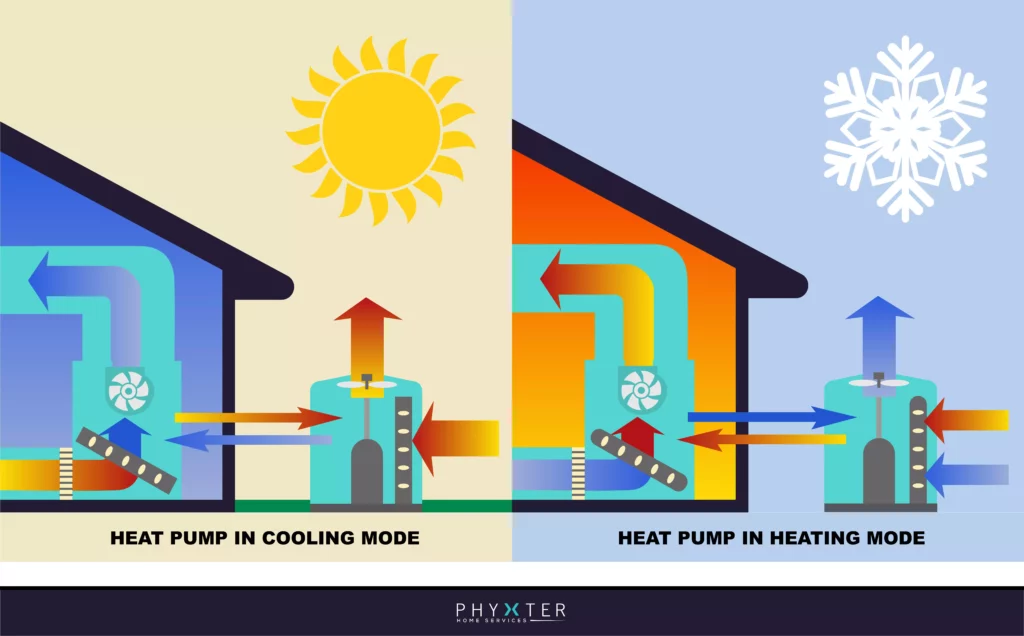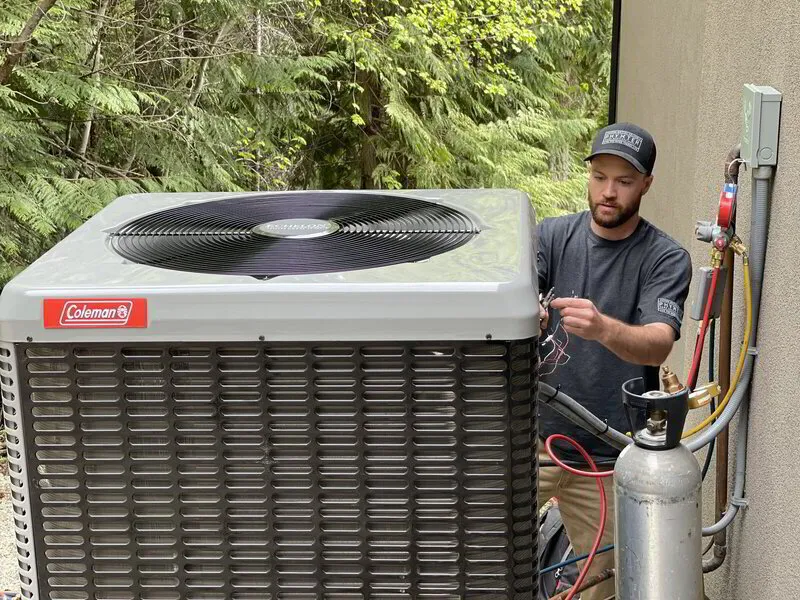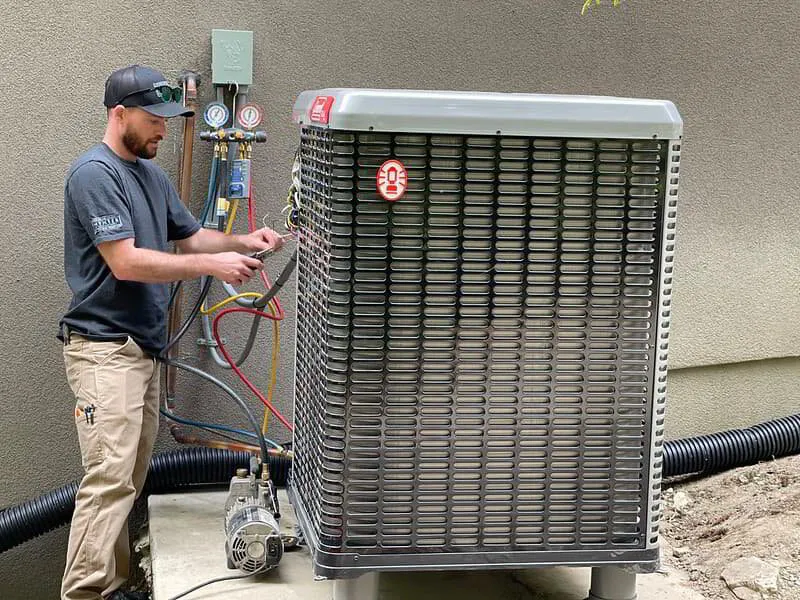Delving into the world of heat pump technology, this guide thoroughly explains the question, 'How does a heat pump work?'. It covers various types of heat pumps, their benefits, installation processes, and upcoming trends in the field.
This article is a valuable resource for anyone looking to grasp the essentials of this efficient heating and cooling system solution, ensuring readers gain a comprehensive insight into the workings and advantages of heat pump systems.
📘 Key Takeaways
- Heat Pump Basics: Heat pumps are energy-efficient systems that transfer heat for heating and cooling, rather than generating it directly.
- Types of Heat Pumps: There are four main types - air-source, geothermal, water source, and absorption heat pumps, each with unique benefits and applications.
- Geothermal and Water Source Efficiency: Geothermal heat pumps use stable underground temperatures, while water source heat pumps leverage consistent water temperatures for high efficiency.
- Environmental Benefits: Heat pumps significantly reduce carbon emissions and are aligned with eco-friendly practices, especially when combined with renewable energy sources.
- Future of Heat Pumps: Advancements in technology and environmental policies are making heat pumps a key component in sustainable heating and cooling solutions.
Understanding Heat Pumps
Image courtesy of Phyxter Home Services
What is a Heat Pump?
A heat pump is an energy-efficient system for heating and cooling buildings. It operates by transferring heat indoors and outdoors rather than directly generating heat.
There are four primary types of heat pumps:
- Air-source heat pumps, the most prevalent type, transfer heat between the building and the outside air, making them suitable for various climates.
- Geothermal heat pumps leverage the consistent temperatures of the ground, offering high efficiency across different environmental conditions.
- Water source heat pumps use nearby water bodies, such as lakes or ponds, as a heat exchange medium, providing efficient heating and cooling by capitalizing on the stable temperatures of the water.
- Absorption heat pumps, typically powered by natural gas, offer a viable option in areas with limited access to electricity, expanding the adaptability of heat pump technology.
Each type offers unique benefits, such as reduced energy consumption and lower carbon emissions, making heat pumps a sustainable choice for modern heating and cooling needs. Their versatility and efficiency have made them increasingly popular in diverse environments, from residential homes to commercial buildings.
How Heat Pumps Operate
Heat pumps function by moving heat from one place to another using a refrigerant, a substance designed for efficient heat absorption and release.
In the heating mode, the pump extracts external heat, which the refrigerant absorbs. This refrigerant is then compressed, raising its temperature significantly. The heated refrigerant circulates through indoor coils, transferring heat to the interior of the building.
For cooling, this process is reversed. The refrigerant absorbs indoor heat, making the air cooler. It then moves outside, where it is decompressed and releases the heat externally.
A crucial component the heat pump uses in this process is the reversing valve, which changes the direction of the refrigerant flow, allowing the heat pump to switch between heating and cooling modes.
This versatility and the efficient heat transfer process make heat pumps effective for year-round temperature control in various settings.
Types of Heat Pumps
Air-Source Heat Pumps
Air-source heat pumps are a popular and versatile choice for both heating and cooling in various climates. They work by extracting heat from the outside air, transferring it indoors during colder months, and reversing the process to cool buildings in warmer weather.
These systems are particularly efficient in moderate climates, though technological advancements have expanded their effectiveness in colder regions. Compared to other types of heat pumps, air-source models are generally more cost-effective and easier to install, making them a preferred option for many homeowners.
Their efficiency in converting energy to heat often surpasses traditional heating systems, leading to significant energy savings and reduced environmental impact over time.
Geothermal Heat Pumps
Geothermal heat pumps harness stable underground temperatures to heat and cool buildings. They circulate refrigerant or water through underground pipes, absorbing ground heat in winter and dissipating indoor heat in summer.
These systems require sufficient land to install ground loops, making them more suited for rural or suburban areas. Environmentally, they excel by minimizing greenhouse gas emissions, thanks to their reliance on renewable ground heat.
Geothermal systems offer a significant advantage over traditional HVAC systems regarding energy efficiency, often resulting in lower operational costs. Their durability and low maintenance needs further enhance their appeal, providing a sustainable and long-term heating and cooling solution.
Water Source Heat Pumps
Water source heat pumps utilize water bodies, like lakes or ponds, as a means to generate heat for heating and cooling. Depending on the season, these systems operate by transferring heat to or from the water.
In winter, they extract heat from the water, which is relatively warmer than the air, and in summer, they expel heat into it, taking advantage of its cooler temperature.
This method is highly efficient due to the consistent temperatures of water sources. Installation requires access to a suitable water body, making them ideal for properties near these resources.
Water source heat pumps offer an energy-efficient alternative, often outperforming traditional systems in both heating efficiency and environmental impact, making them a sustainable choice for suitable locations.
Absorption Heat Pumps
Absorption heat pumps stand out as they utilize a heat source, such as natural gas, solar-heated water, or geothermal-heated water, instead of electricity to operate. This unique feature makes them particularly suitable for areas with expensive or less available electricity.
They function by absorbing heat through a refrigerant cycle, but instead of a compressor, they use a thermal absorber. This distinction leads to quieter operation and less maintenance.
Ideal for residential and commercial applications, these pumps are especially advantageous in integrating solar and geothermal systems, offering a sustainable and energy-efficient solution in diverse settings, including remote or off-grid locations.
Advantages of Heat Pumps
Energy Efficiency
Heat pumps are notably more energy-efficient compared to conventional heating and cooling systems. Typically, they can deliver up to three to four times more heat energy than the electrical energy they consume.
This efficiency is measured by the Coefficient of Performance (COP), with modern heat pumps often achieving a COP between 3 and 5, significantly higher than electric resistance heaters or standard HVAC systems.
This means for every unit of energy used; heat pumps can produce three to five units of heating or cooling energy. Such efficiency reduces energy consumption and lowers utility bills, making heat pumps a cost-effective and environmentally friendly option for temperature regulation in various settings.
Environmental Impact
Heat pumps significantly contribute to environmental sustainability, primarily by reducing carbon emissions. Their high energy efficiency means less electricity is consumed, lowering greenhouse gas emissions, especially when paired with renewable energy sources.
Unlike conventional systems that burn fossil fuels, heat pumps transfer existing heat, minimizing the reliance on carbon-intensive energy sources. This shift is crucial in urban areas, where reducing air pollution and carbon footprint is a priority.
Additionally, the latest advancements in refrigerants used in heat pumps are geared towards lower global warming potential, further aligning heat pump technology with eco-friendly practices and contributing to a greener, more sustainable future.
Installation and Maintenance
Choosing the Right Heat Pump
Selecting the ideal heat pump requires considering several key factors. Climate plays a crucial role; for instance, air-source heat pumps are more suited to mild climates, while geothermal or water-source heat pumps excel in areas with more extreme temperatures.
The size of your home is also important; larger spaces may need more robust systems. Energy efficiency ratings, like Seasonal Energy Efficiency Ratio (SEER) and Heating Seasonal Performance Factor (HSPF), are critical for ensuring cost-effectiveness and environmental friendliness.
Additionally, evaluate the compatibility with your existing systems (like ductwork) and consider future sustainability trends to make a choice that's suitable for today and the years to come.
Heat Pump Installation Process
Installing a heat pump typically begins with a professional assessment to determine your space's right type and size. For air-source systems, this involves evaluating outdoor and indoor unit placement for optimal efficiency.
Geothermal installations require land for underground loops, and water source pumps need access to a water body. Preparations include clearing the area and ensuring ductwork compatibility. Common challenges include managing space constraints and integrating with existing HVAC systems.
PRO TIP: Consider Landscaping Designs To Enhance Efficiency.
When installing a heat pump, particularly an air source heat pump, consider how your landscaping can enhance its efficiency. Strategic placement of shrubs and trees can provide shade to outdoor units, reducing the ambient temperature around them during hot weather. This can improve the heat pump's efficiency as it won't have to work as hard to expel heat.
However, ensure there's enough clearance around the unit to maintain airflow and easy access for maintenance. Additionally, using plants that require minimal watering near the unit can prevent moisture accumulation, which might affect its performance. This approach boosts efficiency and integrates the heat pump aesthetically into your outdoor space.
Maintenance Tips
Effective maintenance is crucial for the optimal performance and longevity of your heat pump:
- Filter Maintenance: Regularly clean or replace air filters every few months to maintain airflow and system efficiency.
- Outdoor Unit Care: Keep the area around outdoor units clear of leaves, debris, snow, or overgrown vegetation to ensure unobstructed airflow.
- Annual System Check: Conduct yearly inspections and cleaning of ducts, coils, and fans to prevent efficiency loss.
- Gentle De-icing: In colder climates, carefully remove ice from the outdoor unit using a spray of lukewarm water, avoiding hot water to prevent thermal shock.
- Noise Check: Listen for unusual sounds, which can indicate potential issues.
- Professional Servicing: Schedule regular professional check-ups for components like refrigerant levels and electrical connections.
- Thermostat Settings: Regularly check and adjust thermostat settings to ensure energy-efficient operation.
These steps, including unique tips like gentle de-icing and noise monitoring, help maintain your heat pump's performance and can lead to significant energy savings.
Innovations and Future Trends
Technological Advancements
Recent advancements in heat pump technology have significantly enhanced their performance and efficiency:
- Variable Speed Compressors: These precisely adjust cooling and heating output, reducing energy consumption and improving efficiency.
- Advanced Refrigerants: New refrigerants with lower global warming potential (GWP) are being used, making heat pumps more environmentally friendly.
- Smart Thermostat Integration: Allows for precise control and remote monitoring, optimizing energy use and convenience.
- Cold Climate Heat Pumps: Designed to operate efficiently in extremely cold temperatures, expanding the usability of heat pumps in colder regions.
These innovations are paving the way for heat pumps to be a central component in sustainable heating and cooling solutions.
The Future of Heat Pumps
The future of heat pumps in both residential and commercial settings looks promising, driven by environmental policies and technological innovations.
As global efforts to reduce carbon emissions intensify, heat pumps will likely become a primary choice for sustainable heating and cooling, supported by government incentives and regulations favoring green technology.
Technological advancements will further enhance their efficiency and adaptability to various climates, including extreme conditions. We may see a rise in hybrid systems, combining heat pumps with renewable energy sources like solar power.
Additionally, integrating AI and IoT for smarter, more efficient energy management is expected to revolutionize their functionality, making heat pumps a cornerstone of modern, eco-friendly building design.
Innovative Perspectives on Heat Pump Technology
As we explore the evolving landscape of heat pump technology, it's clear that these systems are not just a part of the present but are also pivotal in shaping the future of sustainable energy.
From smart home integration to groundbreaking advancements in materials and design, heat pumps are at the forefront of innovation.
Here are some key areas where heat pump technology is breaking new ground:
- Integration with Smart Home Systems: Future advancements may see heat pumps more deeply integrated with smart home systems for enhanced energy management and comfort control.
- AI and Machine Learning Applications: Utilizing AI and machine learning for predictive maintenance and efficient operation, optimizing energy use based on patterns and external factors.
- Multi-Functional Heat Pumps: Emerging designs focus on heat pumps that can also purify water, filter air, or serve as emergency power sources.
- Nano-technology in Components: Implementing nano-technology in components like heat exchangers could drastically improve efficiency and reduce unit size.
- Heat Pumps in District Heating: Utilizing heat pumps in urban district heating systems, efficiently distributing heat from renewable sources or industrial processes.
- Biodegradable Refrigerants: Developing environmentally friendly refrigerants with Low Global Warming Potential (GWP) to minimize ecological impact.
- Comparison with Other Renewable Energy Sources: Heat pumps offer consistent and reliable heating and cooling, unlike solar and wind energy, which depend on weather conditions. While their initial investment might be higher, their operational efficiency and lower long-term costs make them competitive. Paired with green electricity sources, heat pumps can significantly reduce carbon footprints, making them a sustainable choice in diverse environments.
These insights underscore the technological advancements in heat pumps and highlight their growing significance in the realm of eco-friendly and efficient energy solutions.
Conclusion to How Does a Heat Pump Work
In this guide, we've examined heat pumps, showcasing their types, functionality, and advancements that mark them as vital for sustainable living.
We've covered the adaptability of air-source pumps, the efficiency of geothermal systems, and the innovation in absorption heat pumps, highlighting their suitability for diverse settings.
The integration of smart technology and future prospects like AI and eco-friendly refrigerants emphasize their role in eco-friendly solutions.
At DIY Home Comfort, our expertly crafted and well-researched content, backed by authoritative sources, is designed to navigate you through sustainable and efficient home solutions. We're committed to helping homeowners make informed, environmentally conscious decisions.
Don't stop here – continue exploring our array of articles for more insights and tips on home improvement. Stay informed and inspired for your next eco-friendly home project with DIY Home Comfort.
Scott Harding
Scott is the main author of DIY Home Comfort. He's also an experienced HVAC technician that enjoys home renovation and spending time with his family. You can find out more about him here.





